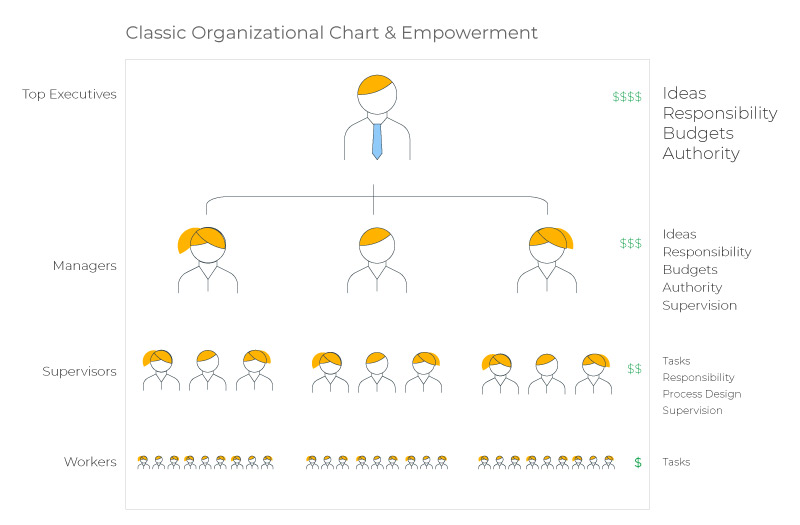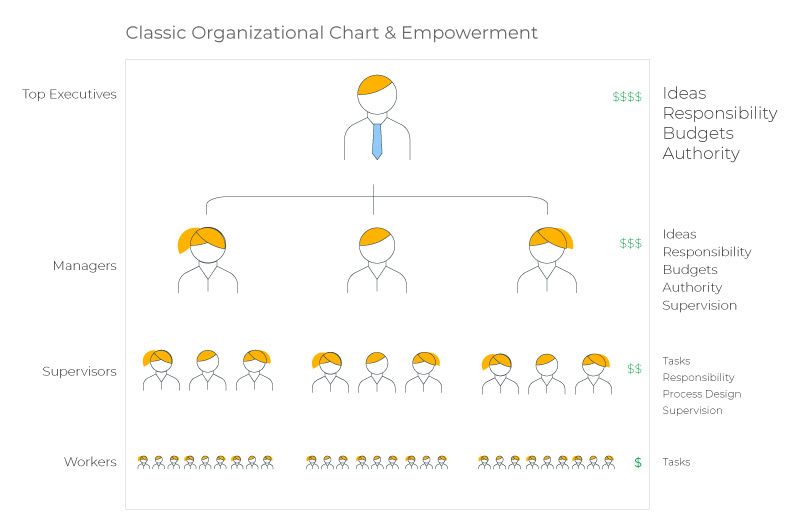If you go back only 100 years, to the turn of the 20th century, there were very few big institutions. The Roman Catholic Church, the governments of a few large nations, and the militaries of several wealthy nations were our best models. So it’s no surprise that as industry began to expand – and rapidly! – the model it used was the hierarchical model of militaries and dynasties.

At the time, this model made sense:
- Education among working class people was generally very low.
- Only elite members of society had the training or background to lead.
- Productivity and Standardization required constant supervision.
Unfortunately, this hierarchical model of management has inefficiency baked into it. It results in top-heavy management and inefficient allocation of labor dollars. It also creates functional silos that result in poor communication, limited collaboration, and delays in decision-making.
Today, We Have the Tools for Change
The education gap was solved over 50 years ago. And since that time, two other areas have rapidly evolved: Quality Systems and Technology. This means it is now possible to structure businesses around team-based business models. And, I would argue, it's also essential.
Quality Systems – like Lean Manufacturing, Six Sigma, and ISO – have created process standardization strategies that do not rely on a manager or supervisor to be successful. Technology has evolved to the point where much of what once had to be monitored and controlled by a manager can now be monitored and controlled by systems.
Motivation and Innovation Are Keys to Competitiveness
When Henry Ford started his manufacturing operations, his main objective was to control the workforce. But today’s intensely competitive, responsive business environment means business must move beyond control. The key to competitiveness today is talent acquisition, talent retention, and innovation. But today’s highly mobile workforce does not respond well to command-and-control environments. Unless you are running an organization that is dedicated to being the cheapest and fastest in its market space (think Walmart), you need a new management structure.
Team-Based Business Models Are the Answer
A team-based management structure can solve for many of the limitations of command-and-control structures. When structured properly and supported with strategic alignment and KPI tools (think Balanced Scorecard), team-based management can be extremely nimble and creative. Moreover, younger generations (from young Gen X to the emerging Millennial workforce) are attracted to companies that use this management approach. What does this look like?
How do Teams Work?
A team-based structure starts with the expectation that “Leadership establishes the ‘what’, and teams establish the ‘how’.” This approach is at the heart of quality systems like Lean Manufacturing. It draws all the workers in the organization into the important work of process design and quality, which improves process outcomes. It also leads to increased commitment and motivation on the part of employees, as they are trusted with and engaged in contributing to improvements in their work.
The traditional middle-management layer is replaced by coordination, in the form of Team Leaders, Team Coordinators, Coaches . . . whatever a business wants to call them. Instead of having authority over a vertical silo of workers, Team Coordinators know their responsibility is to train team members, lead team members in improving processes and quality outcomes, assist with the work of the team, and collaborate with other Team Coordinators.
By implementing tools like the problem-solving tools of Lean Manufacturing, Six Sigma, or Theory of Constraints (TOC), teams can bring their practical knowledge to the table and ensure they participate in creating quality outcomes. By implementing strategic tools like Balance Scorecard (which makes corporate strategy visible and measurable to the entire company, and distills strategy to what is important at each team level), teams align with one another across the organization to pursue shared goals.
The Results
Just implementing teams is not enough to guarantee success. It is essential to also implement quality assurance strategies (Lean, Six Sigma, TOC) and a system to codify strategy and KPIs (Balanced Scorecard). But when these elements come together, the results include:
- Faster decision-making and problem-solving.
- Much higher levels of process standardization and quality.
- Process innovation.
- Change-orientation and faster implementation of change.
- Higher levels of employee morale and motivation.
- Higher levels of employee commitment.
- Shift in labor cost from “supervision” roles to value-add roles.
If you have been looking for a way to help your organization move faster, get ahead of your competition, and produce higher quality, a team-based structure could be the approach you’ve been searching for.












